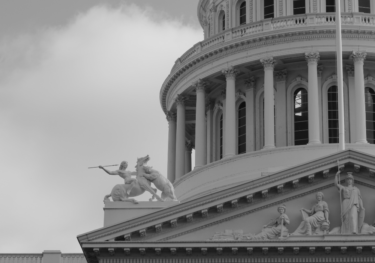Trumponomics: The economics of a second Trump presidency
Continuing our series of analyses on the 2024 election, we modeled the macroeconomic impact of a second Donald Trump presidency. If the former president wins on Election Day, he will most likely return to the White House with Republican majorities in the House of Representatives and Senate. Assuming full Republican control of government after the 2024 election, we constructed two scenarios that bookend a range of outcomes for the US economy. Both would likely push inflation above the baseline.
What you will learn:
- Our first “limited Trump” scenario assumes a Republican-led Congress extends the personal tax cuts under the 2017 tax law and enacts higher spending levels, while the president uses his presidential powers to reduce immigration and impose targeted tariffs on China and the EU. These policy changes raise the level of real GDP 0.6% higher than our baseline in 2027 and add as much as 0.3ppts to the Federal Reserve’s preferred measure of inflation – the core personal consumption expenditure deflator – in late 2027 and early 2028.
- The second “full-blown Trump” scenario assumes Republicans prevent the expiration of the personal tax cuts under the 2017 tax law and cut corporate taxes, and lawmakers agree to even higher spending levels. At the same time, the president curbs immigration to a greater extent and imposes across-the-board tariffs on major trading partners. In this scenario, inflation would be even higher, while the renewed trade wars more than offset the benefit from lower taxes, dragging down the level of real GDP as much as 1.8% lower relative to our baseline. The economy slows to a pace that is well below its potential growth rate.
Tags:
Related Services

Post
Trumponomics – the economics of a second Trump presidency | Beyond the Headlines
The 2024 US Presidential Election is less than seven months away. In this week’s Beyond the Headlines, Bernard Yaros, Lead Economist, outlines two scenarios for the US economy if former President Donald Trump returns to the White House and Republicans sweep Congress.
Find Out More
Post
The long-term benefits of more immigration for the US
Immigration has become the key driver of population growth, and that trend will only accelerate. Based on our forecast, immigration will account for close to 100% of population growth by 2050.
Find Out More
Post
US presidential election – Much ado about nothing
History suggests that presidential elections are not a significant driver of asset returns. That is, asset returns around elections are, on average, the same as returns outside of election windows. We expect this year to be no different.
Find Out More